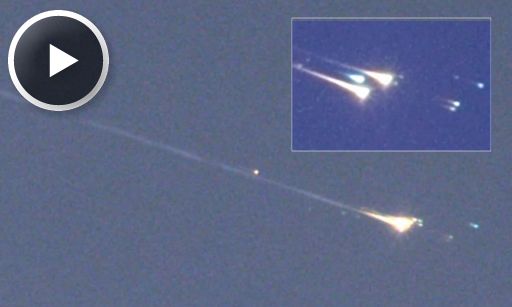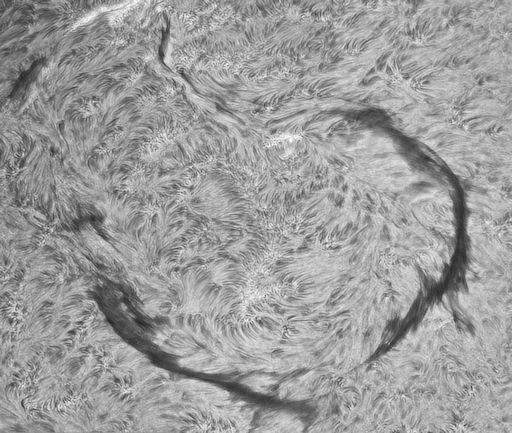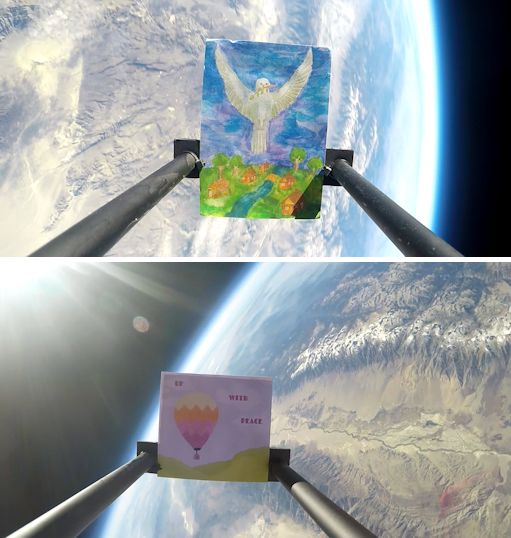Marianne's Heaven On Earth Aurora Chaser Tours Chasethelighttours.co.uk invites you to join them in their quest to find and photograph the Aurora Borealis. Experience the winter wonderland in the Tromsø Area. | | |
CME MISSES EARTH... A CME expected to hit Earth's magnetic field on Nov. 12th did not. The solar storm cloud apparently missed our planet. Or maybe the CME is moving much more slowly than expected, which would mitigate its impact when it eventually arrives. Either way, the chance of a geomagnetic storm today is low. Aurora alerts: text or voice
...BUT MYSTERY OBJECT HITS: A research aircraft organized by the UAE Space Agency and the International Astronomy Center is reporting the first images of WT1190F disintegrating off the coast of Sri Lanka on Friday the 13th. Click to view a movie of the fireball:

As predicted by the European Space Agency, the fireball was easy to see in the blue noon sky over the Indian Ocean--but only at aviation altitudes. Many observers on the ground could not see the fireball through widespread cloud cover. It was actually raining in Sri Lanka when the re-entry occured.
WT1190F is a piece of space junk discovered by the Catalina Sky Survey on Oct. 3rd. Before the impact, astrophysicist Jonathan McDowell told Nature that "the object is only 1 to 2 metres in size, and its trajectory shows that it has a low density, and is perhaps hollow. That suggests an artificial object, 'a lost piece of space history that's come back to haunt us." The translunar orbit of WT1190F is a clue to its origin: probably an old Moon mission. It could be a spent rocket stage or lunar module from the Apollo program.
The research aircraft was staffed, in part, by a group of experienced observers from NASA and the Seti Institute who have recorded many previous re-entries. According to their web site, "we have incredible imaging data and also succeeded in doing quality spectroscopy at blue and red wavelengths, which is a first for us in daytime conditions." Perhaps these data will provide clues to the origin of WT1190F. Stay tuned.
Realtime Space Weather Photo Gallery
GREAT CIRCLE OF MAGNETISM: A dark filament of magnetism in the sun's southern hemisphere has curled upon itself to form a circle of gargantuan porportions. The circumference of the ring is almost a million kilometers--dimensions that make it an easy target for backyard solar telescopes. Amateur astronomer Peter Desypris sends this picture from Athens, Greece:

"I could not fit the entire ring in my telescope's field of view," says . "This is a mosaic of two images."
Bushy magnetic filaments are often unstable, and they have a tendency to collapse. Filaments crashing to the surface of the sun can cause of a type of explosion called a Hyder flare. Any flare from this filament could be extra-energetic as it releases the tension stored in its million-km coil. Amateur astronomers are encouraged to monitor the structure for possible developments. Solar flare alerts: text or voice
Realtime Space Weather Photo Gallery
NOBEL ART EXHIBIT AT THE EDGE OF SPACE: In Barcelona, Spain, the 2015 World Summit of Nobel Peace Laureates is about to begin. From Nov. 13th through 15th, dozens of Nobel Prize winners will gather to promote global peace and freedom. As they work, the laureates will be surrounded by hundreds of peace-themed paintings by young people. A preview of this unique exhibit was recently seen ... at the edge of space:

The top frame shows Dove of Peace, a painting by Aleksandra Manafova, 11, of St. Petersburg, Russia. The bottom frame displays Up with Peace, by Pace Academy freshman Caelan Corbally, 15, of Atlanta, Georgia. Both were flown to the stratosphere in October onboard an Earth to Sky Calculus research balloon.
Linden Longino, CEO of International Paint Pals, is organizing the Nobel Art exhibit, and he arranged to have these samples sent to the stratosphere.
"One hundred countries were invited to have children participate in the exhibition, and 83 said 'yes'--a phenomenal response," says Longino. "Out of 2,000 works of art we received, the best 166 (two from each country) were chosen to be displayed at the Nobel Summit. Of those, two were further selected for the Earth to Sky 'space exhibit' because of their relevance to flight and their 'uplifting' nature."
Longino's donation of $1000 to Earth to Sky Calculus not only propelled two fine pieces of art to the edge of space, but also allowed the students of Earth to Sky to continue their ongoing measurements of cosmic radiation in the stratosphere with two space weather balloon flights in October. Thank you, Linden!
Realtime Aurora Photo Gallery
Realtime Taurid Photo Gallery
Realtime Meteor Photo Gallery
Every night, a network of
NASA all-sky cameras scans the skies above the United States for meteoritic fireballs. Automated software maintained by NASA's Meteoroid Environment Office calculates their orbits, velocity, penetration depth in Earth's atmosphere and many other characteristics. Daily results are presented here on Spaceweather.com.
On Nov. 13, 2015, the network reported 64 fireballs.
(45 sporadics, 18 Northern Taurids, 1 November omega Orionid)

In this diagram of the inner solar system, all of the fireball orbits intersect at a single point--Earth. The orbits are color-coded by velocity, from slow (red) to fast (blue). [Larger image] [movies]
Potentially Hazardous Asteroids (
PHAs) are space rocks larger than approximately 100m that can come closer to Earth than 0.05 AU. None of the known PHAs is on a collision course with our planet, although astronomers are finding
new ones all the time.
On November 13, 2015 there were potentially hazardous asteroids.
Notes: LD means "Lunar Distance." 1 LD = 384,401 km, the distance between Earth and the Moon. 1 LD also equals 0.00256 AU. MAG is the visual magnitude of the asteroid on the date of closest approach. | | Cosmic Rays in the Atmosphere |
| Situation Report -- Oct. 30, 2015 | Stratospheric Radiation (+37o N) |
| Cosmic ray levels are elevated (+6.1% above the Space Age median). The trend is flat. Cosmic ray levels have increased +0% in the past month. |
| Sept. 06: 4.14 uSv/hr (414 uRad/hr) |
| Sept. 12: 4.09 uSv/hr (409 uRad/hr) |
| Sept. 23: 4.12 uSv/hr (412 uRad/hr) |
| Sept. 25: 4.16 uSv/hr (416 uRad/hr) |
| Sept. 27: 4.13 uSv/hr (413 uRad/hr) |
| Oct. 11: 4.02 uSv/hr (402 uRad/hr) |
| Oct. 22: 4.11 uSv/hr (411 uRad/hr) |
These measurements are based on regular space weather balloon flights: learn more. Approximately once a week, Spaceweather.com and the students of Earth to Sky Calculus fly "space weather balloons" to the stratosphere over California. These balloons are equipped with radiation sensors that detect cosmic rays, a surprisingly "down to Earth" form of space weather. Cosmic rays can seed clouds, trigger lightning, and penetrate commercial airplanes. Our measurements show that someone flying back and forth across the continental USA, just once, can absorb as much ionizing radiation as 2 to 5 dental X-rays. Here is the data from our latest flight, Oct. 22nd:

Radiation levels peak at the entrance to the stratosphere in a broad region called the "Pfotzer Maximum." This peak is named after physicist George Pfotzer who discovered it using balloons and Geiger tubes in the 1930s. Radiation levels there are more than 80x sea level.
Note that the bottom of the Pfotzer Maximim is near 55,000 ft. This means that some high-flying aircraft are not far from the zone of maximum radiation. Indeed, according to the Oct 22th measurements, a plane flying at 45,000 feet is exposed to 2.79 uSv/hr. At that rate, a passenger would absorb about one dental X-ray's worth of radiation in about 5 hours.
The radiation sensors onboard our helium balloons detect X-rays and gamma-rays in the energy range 10 keV to 20 MeV. These energies span the range of medical X-ray machines and airport security scanners.
| | The official U.S. government space weather bureau |
| | The first place to look for information about sundogs, pillars, rainbows and related phenomena. |
| | Researchers call it a "Hubble for the sun." SDO is the most advanced solar observatory ever. |
| | 3D views of the sun from NASA's Solar and Terrestrial Relations Observatory |
| | Realtime and archival images of the Sun from SOHO. |
| | from the NOAA Space Environment Center |
| | the underlying science of space weather |

